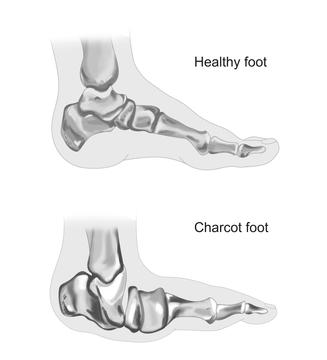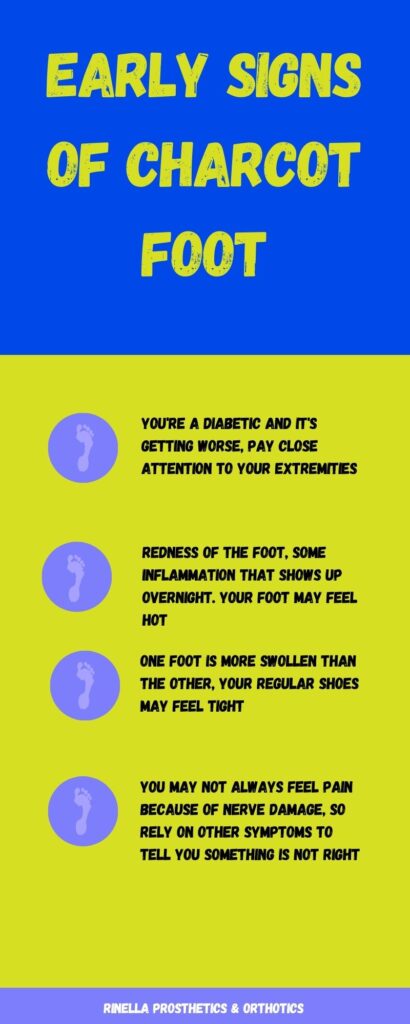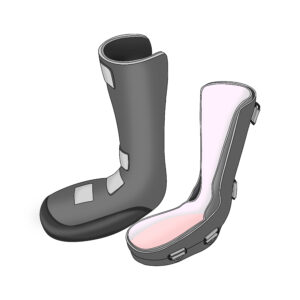It is hard when you get sick, especially if you have to experience the complications that may develop.

What Is Charcot Foot?
Also known as diabetic Charcot Foot syndrome, this is a condition where people may lose their lower limbs, which is an unfortunate complication of diabetes. The bones in the foot weaken and for people who experience nerve damage, the bones become too weak that it ends up becoming fractured sometimes. This scenario may change how the foot looks and operates.
Charcot foot may lead to deformity, disability, or even amputation, which is why people who have diabetes need to take care of themselves and seek doctor’s advice when they notice any signs or symptoms of Charcot Foot.

Causes of Charcot Foot
There are several causes of this condition, one of which is that it is a result of nerve damage, where the person afflicted with Charcot Foot feels nothing much, such as pain or cuts that may appear on the foot or ankle.
Since people with this condition have less sensation, they might not notice that there is something wrong with their foot, so they continue to walk or do physical activity, which may worsen the injury.
Common Symptoms
If you are at risk for Charcot Foot, there are some symptoms to look out for:
1) The afflicted foot may feel hotter to the touch than the other one.
2) There is redness and swelling on the affected foot.
3) A person with this condition may feel sore more than normal.
Risks of Having Charcot Foot
When a patient has Charcot Foot, they are at the risk of having foot ulcers. Especially when the foot seems to change in shape because of the bones fracturing, the friction between the foot and the shoe may result in blisters, leading to ulcers.
When the bones get in disarray, it causes unbalanced weight distribution. When a patient has Charcot Foot, it results in the blood flow to the weakened foot, which may prevent any foot ulcer from healing, making the condition last longer.
Treatment for Charcot Foot
The golden rule for this type of condition is to follow the surgeon’s instructions to the letter and to always reach out if something is wrong.
Nonsurgical options
Immobilization is one of the treatment options for Charcot Foot. The affected foot is put in a cast, or something called a CROW boot. Often times the patient will use crutches to make sure that the foot will not be used for walking or for any physical activity.

This is a depiction of a CROW boot. Solid on the outside to control excessive movement, soft on the inside to promote healing.
The foot can also be fitted for special shoes and inserts not to put pressure on the foot. Bracing can be done to ensure that the affected foot will not be pressured.
The person afflicted with Charcot Foot may be advised by their doctors to hold off any strenuous physical activity to ensure that the foot with the condition can heal.
How to Avoid Charcot Foot
For patients diagnosed with Charcot Foot, they have had to make sure of the following:
- Their sugar levels should be kept under close watch to lessen the risk of experiencing nerve damage on their feet.
- They need to maintain regular checkups with a foot and ankle surgeon.
- They have to check both of their feet every day, and if signs of having Charcot Foot are evident, they need to contact a doctor immediately.
- They need to watch how they go about in their daily lives, the activities they do, and the travel they do from place to place.
What to Do With the Pain
There are several treatment options that a doctor can provide for a patient with Charcot Foot.
Thanks to a question posed online about what can be done with thigh or hip pain, there were several scenarios posed to how doctors and patients kept up with having Charcot Foot.
After interviewing many patients who see us with Charcot foot, we have been told that some were :
1.) Advised to wear an inflatable cast boot for four months, and the patient did not feel any foot problem or experience any pain or swelling. They did not see any redness nor feel any change in temperature for both of the feet, and that there was no visible deformity on either of the feet.
2.) Some of the respondents mentioned using Step Up and made sure the other foot had a shoe on the opposite foot that could even out the height of both of the feet. but it had a tendency to slip off, which is why they had a podiatrist order a shoe that could level off the boot’s height. They also had a shoe made with a rocker bottom and the same height as the Step Up. The patient’s hip pain disappeared altogether after doing it.
3.) One of the respondents mentioned using Even Up, but the patient felt continuous hip and lower back pain during the use of Even Up. The Even up is a shoe lift that attaches to the outside of the shoe. This in the medical field can also be referred to as an external shoe lift. External shoe lifts are good for people who have a considerable leg length discrepancy and if they had too much material added to the inside of their shoe, they might pop in the heel area. Popping out in the heel area is also known as pistoning.
*Please remember to talk with your physician prior to using any of these treatment options mentioned. We interview patients and share the general information that they say works for them. This is not medical advice, but rather health information that you can use to talk with your physician about. We hope that it has helped you and wish you all the best moving forward.
If you’d like know more about foot orthotics and what other patients are saying about charcot foot treatment, visit the Rinella Prosthetics & Orthotics blog.
